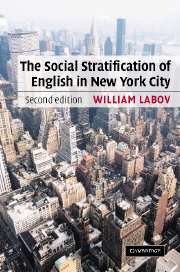Book contents
- Frontmatter
- Contents
- Introductory note
- Preface to the first edition
- Preface to the second edition: forty years later
- I Problems and methods of analysis
- 1 The study of language in its social context
- 2 First approach to the structure of New York City English
- 3 The social stratification of (r) in New York City department stores
- 4 The isolation of contextual styles
- 5 The linguistic interview
- 6 The survey of the Lower East Side
- II Social differentiation
- III Social evaluation
- IV Synthesis
- Glossary of linguistic symbols and terminology
- Appendix A Questionnaire for the ALS Survey
- Appendix B Anonymous observations of casual speech
- Appendix C Analysis of losses through moving of the MFY sample population
- Appendix D Analysis of the non-respondents: the television interview
- Appendix E The out-of-town speakers
- Bibliography
- Index
2 - First approach to the structure of New York City English
Published online by Cambridge University Press: 18 December 2009
- Frontmatter
- Contents
- Introductory note
- Preface to the first edition
- Preface to the second edition: forty years later
- I Problems and methods of analysis
- 1 The study of language in its social context
- 2 First approach to the structure of New York City English
- 3 The social stratification of (r) in New York City department stores
- 4 The isolation of contextual styles
- 5 The linguistic interview
- 6 The survey of the Lower East Side
- II Social differentiation
- III Social evaluation
- IV Synthesis
- Glossary of linguistic symbols and terminology
- Appendix A Questionnaire for the ALS Survey
- Appendix B Anonymous observations of casual speech
- Appendix C Analysis of losses through moving of the MFY sample population
- Appendix D Analysis of the non-respondents: the television interview
- Appendix E The out-of-town speakers
- Bibliography
- Index
Summary
[The first half of this chapter demonstrates the practical difficulties for the linguist in dealing with inherent variation – where it is not possible at any one time to predict which of several alternatives a speaker will adopt in the stream of speech. New York City was a classic case, and the definition of five linguistic variables. The concept of the linguistic variable is probably the most influential and widely adopted aspect of the approach to linguistics the absence of it.]
It is safe to say that the language of New York City is better known to the people of the United States as a whole than the language of any other single city. The great majority of our informants report that whenever they travel outside of the city, they are quickly identified as New Yorkers. On radio and television, stereotypes of middle class and working class New York speech have traditionally been used for comic effects. For many years, several other features of working class and lower class New York City speech have been stigmatized under the label of Brooklynese. In Minnesota or Pittsburgh, the speech of lower class New Yorkers may be imitated by boys who think of this style as a symbol of the tough, hard life and defiance of authority. Indeed, some of these sound features have entered into a folk mythology.
- Type
- Chapter
- Information
- The Social Stratification of English in New York City , pp. 18 - 39Publisher: Cambridge University PressPrint publication year: 2006



